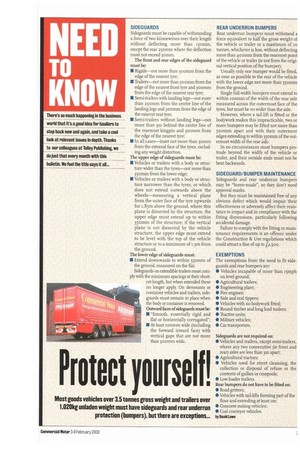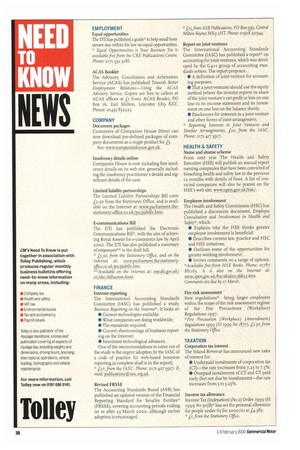Protect yoursel f!
Page 31

Page 32

If you've noticed an error in this article please click here to report it so we can fix it.
Most goods vehicles over 3.5 tonnes gross weight and trailers over 1,020kg unladen weight must have sideguards and rear underrun protection (bumpers), but there are exceptions...
Sideguards must be capable of withstanding a force of two kilonewtons over their length without deflecting more than 150mm, except the rear 25o m m where the deflection must not exceed 3o mm.
The front and rear edges of the sideguard must be: • Rigids—not more than 3oomm from the edge of the nearest tyre; • Trailers—not more than 5oomm from the edge of the nearest front tyre and 3oomm from the edge of the nearest rear tyre; • Semi-trailers with landing legs—not more than 25omm from the centre line of the landing legs and 3oomm from the edge of the nearest rear tyre; • Semi-trailers without landing legs—not more than 3m behind the centre line of the rearmost kingpin and 3oomm from the edge of the nearest tyre; • In all cases—inset not more than 3omm from the external face of the tyres, excluding any weight distortion.
The upper edge of sideguards must be: • Vehicles or trailers with a body or structure wider than the tyres—not more than 350mm from the lower edge; • Vehicles or trailers with a body or structure narrower than the tyres, or which does not extend outwards above the wheels—measuring a vertical plane from the outer face of the tyre upwards for 1.85m above the ground, where this plane is dissected by the structure, the upper edge must extend up to within 35omm of the structure; if the vertical plane is not dissected by the vehicle structure, the upper edge must extend to be level with the top of the vehicle structure or to a minimum of 1.5m from the ground.
The lower edge of sideguards must: • Extend downwards to within 550mm of the ground, measured on the flat.
Sideguards on extendible trailers must comply with the minimum spacings at their shortest length, but when extended these no longer apply. On demounts or container vehicles and trailers, sideguards must remain in place when the body or container is removed_ Outward faces of sideguards must be: • "Smooth, essentially rigid and flat or horizontally corrugated"; • At least ioomm wide (including the forward inward face) with vertical gaps that are not more than 3oomm wide. REAR UNDERRUN BUMPERS Rear underrun bumpers must withstand a force equivalent to half the gross weight of the vehicle or trailer or a maximum of ro tonnes, whichever is less, without deflecting more than 40 omm from the rearmost point of the vehicle or trailer (ie not from the original vertical position of the bumper).
Usually only one bumper would be fitted, as near as possible to the rear of the vehicle with the lower edge not more than 55omm from the ground.
Single full-width bumpers must extend to within ioomm of the width of the rear axle measured across the outermost face of' the tyres, but must be no wider than the axle.
However, where a tail-lift is fitted or the bodywork makes this impracticable, two or more bumpers may be fitted not more than 5 oomm apart and with their outermost edges extending to within 35omm of the outermost width of the rear axle.
In no circumstances must bumpers protrude beyond the width of the vehicle or trailer, and their outside ends must not be bent backwards.
SIDEGUARD/BUMPER MAINTENANCE Sideguards and rear underrun bumpers may be "home-made", so they don't need approval marks.
But they must be maintained free of any obvious defect which would impair their effectiveness or adversely affect their resistance to impact and in compliance with the fitting dimensions, particularly following accidental damage.
Failure to comply with the fitting or maintenance requirements is an offence under the Construction & Use regulations which could attract a fine of up to 2,5oo.
EXEMPTIONS The exemptions from the need to fit sideguards and rear bumpers are: • Vehicles incapable of more than i5mph on level ground; • Agricultural trailers; • Engineering plant; • Fire engines; • Side and end tippers; • Vehicles with no bodywork fitted; • Round timber and long load trailers; • Tractive units; • Military vehicles; • Car transporters.
Sideguards are not required on: • Vehicles and trailers, except semi-trailers, where any two consecutive (ie front and rear) axles are less than 3m apart; • Agricultural tractors; • Vehicles used for street cleansing, the collection or disposal of refuse or the contents of gullies or cesspools; • Low-loader trailers.
Rear bumpers do not have to be fitted on: • Road gritters; • Vehicles with tail-lifts forming part of the floor and extending at least nu; • Concrete mixing vehicles; • Coal conveyor vehicles.
by David Lowe
EMPLOYMENT Equal opportunities The DTi has published a guide* to help small businesses stay within the law on equal opportunities. * Equal Opportunities is Your Business Too is available free from the CRE Publications Centre. Phone: 0171 932 5286.
ACAS Booklet The Advisory, Conciliation and Arbitration Service (ACAS) has published Towards Better Employment Relations—Using the ACAS Advisory Service. Copies are free to callers at ACAS offices or L1 from: ACAS Reader, PO Box 16, Earl Shilton, Leicester LE9 8ZZ. Phone: 01455 852225.
COMPANY Document packages Customers of Companies House Direct can now download pre-defined packages of company documents as a single product for L5.
See: www.companieshouse.gov.uk.
Insolvency details online Companies House is now including free insolvency details on its web site, generally including the insolvency practitioner's details and significant details of the case.
Limited liability partnerships
The Limited Liability Partnerships Bill costs £2.5o from the Stationery Office, and is available on the Internet at: wwvv,parliament.thestationery-office.co.ukipaipabills.htrn.
E-communications Bill
The DTi has published the Electronic Communications Bill*, with the aim of achieving Royal Assent for e-commerce law by April 2000. The DTi has also published a summary of responses** to the draft bill.
* 1,3.3o, from the Stationery Office, and on the Internet at: www.parliament.the-stationeryoffice.co.uk/pa/pabills.htin.
**Available on the Internet at: ww.dti.gov.uki cii/elec/billsumm.html.
FINANCE Internet reporting
The International Accounting Standards Committee (IASC) has published a study, Business Reporting on the Internet*. It looks at:
• Current technologies available; • What companies are doing worldwide; • The standards required; • Current shortcomings of business reporting on the Internet; • Imminent technological advances.
One of the recommendations to come out of the study is the urgent adoption by the IASC of a code of practice for web-based business reporting (a complete draft is in the report). * E2o,from the 1ASC. Phone: 0171 427 5927. Email: publications iasc.org.uk.
Revised F RS S E The Accounting Standards Board (ASB) has published an updated version of the Financial Reporting Standard for Smaller Entities* (FRSSE), covering accounting periods ending on or after 23 March 2000, although earlier adoption is encouraged.
* E15,fiorrt ASE Publications, PO Box 939, Central Milton Keynes I'vf K9 2HT Phone: 0/908 230344.
Report on joint ventures
The International Accounting Standards Committee (IASC) has published a report* on accounting for joint ventures, which was developed by the G4+1 group of accounting standards setters. The report proposes:
• A definition of joint venture for accounting purposes; • That a joint venturer should use the equity method (where the investor reports its share of the joint venture's net profit or loss on one line in its income statement and its investment on one line on the balance sheet); • Disclosures for interests in a joint venture and other forms of joint arrangement. * Reporting Interests in Joint Ventures and Similar Arrangements, Do, from the IASC. Phone: 0171 427 5927.
HEALTH & SAFETY Name and shame scheme
From next year The Health and Safety Executive (HSE) will publish an annual report naming companies that have been convicted of breaching health and safety law in the previous 12 months with details of fines. A list of convicted companies will also be posted on the HSE's web site: www.open.gov.ukihsef.
Employee involvement
The Health and Safety Commission (H SC) has published a discussion document, Employee Consultation and Involvement in Health and Safety*, which:
• Explains why the HSE thinks greater employee involvement is beneficial; • Describes current law, practice and HSC and HSE initiatives: • Outlines some of the opportunities for greater workmg involvement;
• Invites comments on a range of options. *Available free from HSE Books. Phone: 01787 881165. It is also on the Internet at: www.opensov.uk/hse/disdocs/ddelz.htm. Comments are due by 17 March.
Fire risk assessment New regulations* bring larger employers within the scope of the risk assessment regime of the Fire Precautions (Workplace) Regulations 1997.
*Fire Precaution (Workplace) (Amendment) Regulations 1999 ( SI 1999 No 1877), 12.5o,from the Stationery Office.
TAXATION Corporation tax interest
The Inland Revenue has announced new rates of interest for:
• Underpaid instalments of corporation tax (CT)—the rate increases from 7.25 to 7.5%; • Overpaid instalments of CT and CT paid early (but not due by instalments)—the rate increases from 5 to 5.25%.
Income tax allowance Income Tax (Indexation) (No 2) Order 1999 (SI 1999 No 3o38)* has set the personal allowance for people under 65 for 2000/01 at /4,385. * Li, from the Stationery Office.




































































































